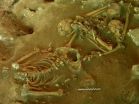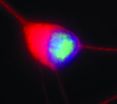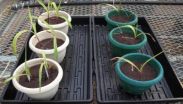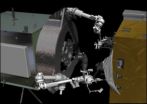(Press-News.org) Researchers from New Zealand's University of Otago studying 3000-year-old skeletons from the oldest known cemetery in the Pacific Islands are casting new light on the diet and lives of the enigmatic Lapita people, the likely ancestors of Polynesians.
Their results—obtained from analysing stable isotope ratios of three elements in the bone collagen of 49 adults buried at the Teouma archaeological site on Vanuatu's Efate Island—suggest that its early Lapita settlers ate reef fish, marine turtles, fruit bats, free-range pigs and chickens, rather than primarily relying on growing crops for human food and animal fodder.
The findings are newly published in the prestigious international journal PLOS ONE. Study lead author Dr Rebecca Kinaston and colleague Associate Professor Hallie Buckley at the Department of Anatomy carried out the research in collaboration with the Vanuatu National Museum and researchers from the University of Marseilles and CNRS (UMR 7269 and UMR 7041) in France and The Australian National University, Canberra.
Dr Kinaston says the study is the most detailed analysis of Lapita diet ever undertaken and provides intriguing insights into the socio-cultural elements of their society.
"It was a unique opportunity to assess the lifeways of a colonising population on a tropical Pacific island," she says.
The researchers analysed the isotopic ratios of carbon, nitrogen and sulphur in adult human bone collagen and compared these with ratios in ancient and modern plants and animals from the location, which provided a comprehensive dietary baseline.
"Examining these ratios gave us direct evidence of the broad make-up of these adults' diets over the 10-20 years before they died, which helps clear up the long-running debate about how the Lapita settlers sustained themselves during the early phases of colonising each island during their eastward drive across the Pacific."
Dr Kinaston says it appears that the new colonists, rather than relying mainly on a "transported landscape" of the crop plants and domesticated animals they brought with them, were practicing a mixed subsistence strategy.
"The dietary pattern we found suggests that in addition to eating pigs and chickens, settlers were also foraging for a variety of marine food and consuming wild animals—especially fruit bats—and that whatever horticultural food they produced was not heavily relied on," she says.
Isotopic analysis of the ancient pig bones found at the site also suggests that they were free-ranging rather than penned and given fodder from harvested crops.
Study of the human bones revealed a sex difference in diet compositions, showing that Lapita men had more varied diets and greater access to protein from sources such as tortoises, pigs and chicken than women did.
"This may have resulted from unequal food distribution, suggesting that males may have been considered of higher status in Lapita society and treated preferentially," Dr Kinaston says.
INFORMATION:
Grants that funded the overall research project came from the Australian Research Council, Pacific Biological Foundation, National Geographic Society, Royal Society of New Zealand-administered Marsden Fund and the University of Otago. Other funding came from CNRS: Aix-Marseille Université.
Researchers gain new insights into ancient Pacific settlers' diet
2014-03-06
ELSE PRESS RELEASES FROM THIS DATE:
Atypical development in the siblings of children with autism is detectable at 12 months
2014-03-06
(SACRAMENTO, Calif.) — Atypical development can be detected as early as 12 months of age among the siblings of children with autism spectrum disorder, a study published by researchers with the UC Davis MIND Institute and UCLA has found.
Published online in the Journal of the American Academy of Child and Adolescent Psychiatry, the study found that close to half of the younger siblings of children with autism spectrum disorder (ASD) develop in an atypical fashion, with 17 percent developing ASD and another 28 percent showing delays in other areas of development or behavior. ...
Study: Alzheimer's disease a much larger cause of death than reported
2014-03-05
MINNEAPOLIS – A new study suggests that Alzheimer's disease may contribute to close to as many deaths in the United States as heart disease or cancer. The research is published in the March 5, 2014, print issue of Neurology®, the medical journal of the American Academy of Neurology.
Currently, Alzheimer's disease falls sixth on the list of leading causes of death in the United States according to the Centers for Disease Control and Prevention (CDC), whereas heart disease and cancer are numbers one and two, respectively. These numbers are based on what is reported on ...
Restless legs syndrome may signify bigger health problems
2014-03-05
(Boston)--A nationally-recognized sleep expert has published an editorial describing Restless Legs Syndrome (RLS) as a possible biomarker for underlying disease. The editorial appears in the March 5, 2014 issue of Neurology the medical journal of the American Academy of Neurology and was authored by Boston Medical Center neurologist Sanford H. Auerbach, MD.
RLS is a disorder of the nervous system. Patients with RLS have uncomfortable sensations in their legs which lead to an overwhelming urge to move them – most often at night or whenever the patient is resting.
The ...
Applying math to cancer, climate, crime and cameras
2014-03-05
Improving radiation therapies for cancer mathematically
In a paper published in December in the SIAM Journal on Scientific Computing, authors Li-Tien Cheng, Bin Dong, Chunhua Men, Xun Jia, and Steve Jiang propose a method to optimize radiation therapy treatments in cancer patients.
Radiation therapy is one of the primary methods used for cancer treatment, along with chemotherapy and surgery. While doses of radiation are delivered to eliminate cancerous tissue, care is taken to keep radiation within acceptable levels so as not to affect neighboring tissues and organs. ...
3-D changes in DNA may lead to a genetic form of Lou Gehrig's disease
2014-03-05
New findings reveal how a mutation, a change in the genetic code that causes neurodegeneration, alters the shape of DNA, making cells more vulnerable to stress and more likely to die.
The particular mutation, in the C9orf72 gene, is the most common cause for amyotrophic lateral sclerosis (ALS, also known as Lou Gehrig's disease), and frontotemporal degeneration (FTD), the second most common type of dementia in people under 65.
This research by Jiou Wang, Ph.D., and his colleagues at Johns Hopkins University (JHU) was published in Nature and was partially funded by ...
Look back at US soybeans shows genetic improvement behind increased yields
2014-03-05
URBANA, Ill. – Soybean improvement through plant breeding has been critical over the years for the success of the crop. In a new study that traces the genetic changes in varieties over the last 80 years of soybean breeding, researchers concluded that increases in yield gains and an increased rate of gains over the years are largely due to the continual release of greater-yielding cultivars by breeders.
"This research in some ways looks back and informs us how soybean varieties have changed. It's useful to document these traits and changes," said Brian Diers, a University ...
Fertility prospects following ectopic pregnancy
2014-03-05
WINSTON-SALEM, N.C. – March 5, 2014 – Preserving a fallopian tube following an ectopic pregnancy seems like it would favor a woman's fertility prospects, right?
A new study from Wake Forest Baptist Medical Center looked at pregnancy outcomes in regards to the two surgical treatments for ectopic pregnancy -- salpingectomy, in which the affected fallopian tube is removed, or salpingotomy, in which the tube is preserved.
The aim of the study, said co-author Tamer Yalcinkaya, M.D., a reproductive endocrinologist at Wake Forest Baptist, was to assess whether salpingotomy ...
Maize and bacteria: A 1-2 punch knocks copper out of stamp sand
2014-03-05
Scientists have known for years that together, bacteria and plants can remediate contaminated sites. Ramakrishna Wusirika, of Michigan Technological University, has determined that how you add bacteria to the mix can make a big difference.
He has also shed light on the biochemical pathways that allow plants and bacteria to clean up some of the worst soils on the planet while increasing their fertility.
Wusirika, an associate professor of biological sciences, first collected stamp sands near the village of Gay, in Michigan's Upper Peninsula. For decades, copper mining ...
NASA tests new robotic refueling technologies
2014-03-05
NASA has successfully concluded a remotely controlled test of new technologies that would empower future space robots to transfer hazardous oxidizer – a type of propellant – into the tanks of satellites in space today.
Concurrently on the ground, NASA is incorporating results from this test and the Robotic Refueling Mission on the International Space Station to prepare for an upcoming ground-based test of a full-sized robotic servicer system that will perform tasks on a mock satellite client.
Collectively, these efforts are part of an ongoing and aggressive technology ...
OU study suggests non-uniform climate warming global
2014-03-05
A recent University of Oklahoma study of five decades of satellite data, model simulations and in situ observations suggests the impact of seasonal diurnal or daily warming varies between global regions affecting many ecosystem functions and services, such as food production, carbon sequestration and climate regulation. The effects of non-uniform climate warming on terrestrial ecosystems is a key challenge in carbon cycle research and for those making future predictions.
Jianyang Xia, a research associate in the OU College of Arts and Sciences, says the impact of non-uniform ...



